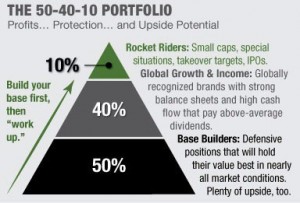We talked last Friday about the three bad investing habits that kill returns, and I asked you to let go of them in 2015.
I can almost guarantee you’ll be better off for it – and so will your brokerage account.
Now I want to show you what to do instead.
[ad#Google Adsense 336×280-IA]This first investing strategy is absolutely priceless…
Good Investing Habit No. 1: Have a Plan and Stick to It
If you only use one investing tactic, please use this one.
That’s because more than any other factor, discipline makes all the difference in preserving your capital and, more importantly, in growing it.
That’s where 99% of most investors fail and, in the process, doom themselves to subpar returns.
The proprietary 50-40-10 structure allocation model I pioneered in our sister publication, the Money Map Report, is a great place to start.
 Sometimes it’s really tough to stay disciplined, especially when you find an exciting new “Rocket Rider” – like our Ekso Bionics Holdings Inc. (OTCMKTS: EKSO) and you’ve already got 10% of your capital in more aggressive positions.
Sometimes it’s really tough to stay disciplined, especially when you find an exciting new “Rocket Rider” – like our Ekso Bionics Holdings Inc. (OTCMKTS: EKSO) and you’ve already got 10% of your capital in more aggressive positions.
But that’s actually when you need discipline the most.
By concentrating assets and periodically rebalancing between core assets, growth/income, and speculative positions, you are effectively “forcing” yourself to buy low and sell high using proven logic – not emotion. Plus, this keeps performance-robbing fees low, which Wall Street hates but you’ll love because it can add a lot to your returns over time.
There are always companies like Ekso out there. If anything, finding more of them is an incentive to invest more often, perhaps even forgoing the $5 designer coffee every day.
The other thing to think about is that you’ll sleep well at night even if the markets pitch a hissy fit because the concentration and built-in protection it offers ensure you’re high on stability and upside at the same time.
Good Investing Habit No. 2: Take a Measured Approach When You Buy
Many investors spend more time thinking about a new flat-screen TV than they do their next triple-digit winner. So they make the mistake of going all in. They may as well head over to the casinos in Vegas, which love this kind of thinking.
There’s a much smarter way to put your money to work…
By dollar-cost averaging into positions over time, you split your money into chunks instead of investing it all at once. That way you’re actually forcing yourself to overcome the recency bias associated with big down days or bad news that rocks the markets. Plus, you’re focused on upside and have to take a longer-term perspective.
Dollar-cost averaging works especially well when you are making a large investment because it minimizes your downside risk.
I get asked a lot about how long people should average in. In other words, what period – two weeks or two years – is most effective? That varies depending on your risk tolerance, but I think splitting money up over a 3- to 5-month horizon is a good start because you can work your way in no matter whether the markets are moving up, moving down, or moving sideways.
Good Investing Habit No. 3: Use Trailing Stops
And finally, you’ve simply got to have a built-in, emotionless way of capturing profits and protecting your capital.
Technically speaking, trailing stops are a “stop-loss” order that’s set at a specific price below the market price of the investment you’re holding.
A trailing stop helps you stay in a stock that’s running higher but ensures that you get clear if it drops by a predetermined amount. And it helps limit losses to small, manageable amounts rather than allowing them to become catastrophic portfolio killers.
What I like about them, especially in the context of good habits, is that trailing stops are typically moved upward in lockstep with an investment making new highs, but are almost never revised downward.
Conventional wisdom tells you to sell your losers and let your winners run. I think that’s backwards. Nobody ever made money by selling losers. You have to periodically sell your winners without interference, and trailing stops let you do that.
Plus, trailing stops make great “harvesters” when the markets look toppish, as they do now. That’s because they automatically instill discipline and ensure you sell if there’s a correction or a consolidation. There’s no timing and no emotion whatsoever.
Like dollar-cost averaging, I get a lot of questions about trailing stops.
You can run stops at any percentage level you want. My research suggests that starting 25% below your purchase price on any investment is a palatably wide band capable of protecting your money and your profits while ensuring that you don’t get bounced out of trades prematurely by normal volatility.
If you’re a more advanced trader, consider using put options to accomplish the same thing.
Most brokerage firms have online trading platforms that can do this automatically, by the way. If yours doesn’t, consider a simple, inexpensive service like tradestops.com.
These three good investing strategies may seem simple… but sometimes that’s all it takes to make a difference in the pursuit of profits.
— Keith Fitz-Gerald
[ad#sa-trader]
Source: Money Morning
